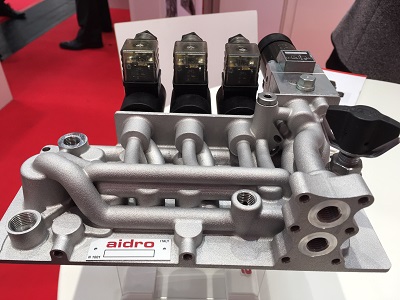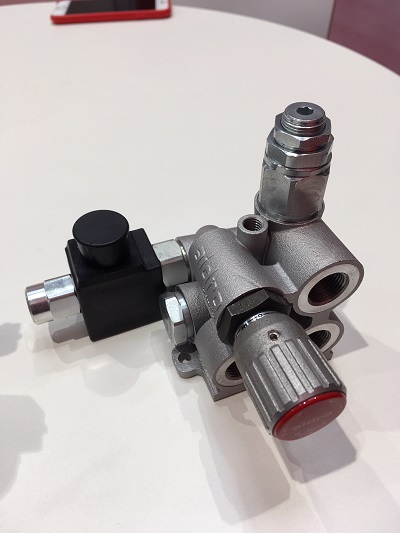Component manufacturer Aidro Hydraulics is pioneering a new approach to production, based on additive manufacturing, that will revolutionize fluid power markets, according to company CEO Valeria Tirelli. While the industry is still in its infancy, the potential benefits are obvious and the limitations are quickly being overcome, she said.

Aidro, based in Taino, Italy, makes high-pressure manifolds, valve blocks and other hydraulic components.
3D printing offers the possibility to create a new generation of hydraulic systems that surpass the limits of conventional hydraulic components. This technology lets Aidro produce fast prototypes, spare parts, and functional products that can routinely reduce size and weight by 75% versus conventional hydraulics components. It is being used to make products like high-pressure (10,000 psi) manifolds, valve blocks, heat exchangers, hydraulic spools and other components.
The process can consolidate multiple parts and functions into one, reconfigure ports to simplify connections and piping, and permit previously impossible complex geometries that improve performance, thanks to the optimization of internal channels, she explained. For instance, machining a traditional manifold often requires cross-drilled passages that must be plugged, creating potential leak paths. And pressure drop at the 90-degree intersection can be excessive. 3D printing permits smooth, curved flow paths that tests have shown improve flow efficiency by 30 to 70%. “So we can have smaller parts but with the same or better functions as a larger hydraulics manifold,” said Tirelli.
While 3D printing isn’t suited for every application, as of yet, interest and acceptance is growing rapidly, she continued. “It’s practical for special applications, because nowadays we have some limitations for additive manufacturing in the number of parts that we can produce. For a typical manifold, we can produce parts for prototyping and for small series in special machinery, but we cannot produce 10,000 pieces. But the 3D printer producers are working on larger machines that run ever faster and have higher productivity, so capabilities are constantly improving.”
“I think today we can say additive manufacturing is perfect for prototypes and special small series, so low-volumes, but in a few years, because machines are getting bigger and faster, I think that this will be a good alternative to traditional manufacturing,” she said. Automobile manufacturer BMW, she noted, is now producing some parts by the thousands with additive manufacturing.
Aidro uses laser power bed fusion technology (LPBF, DMLS or SLM), which ensures a high quality of metal materials and good mechanical properties of the printed parts. Materials are mainly aluminum for light weight, stainless steel for food-industry machines, and Inconel for special application like oil and gas, and offshore. It takes a few hours to print a small manifold, she said.

3D printing permits size and weight reduction and parts consolidation.
Other fluid power companies are dabbling in the technology or relying on contract manufacturers. But she cautions potential users to do their homework. There are service providers with multiple machines that can make parts on contract, but they serve all markets, such as automotive and aerospace, and are not specifically expert on hydraulics.
“It seems simple: make a design, send a file to an external company, and they print it. But in the case of printing a hydraulic manifold with additive manufacturing is not easy. Because we have to take into account the complexity: the flow, pressure, how to orientate the manifold inside the machine, where to position internal supports, and many other issues that really requires expertise about the 3D printing process. So is not easy to design a good 3D-printed manifold and to produce it, because we need more and more knowledge about what is inside,” she said.
“We have special software, of course. But the people are the main point. There is typical topology optimization software for 3D printing which is very good for mechanical parts. But for hydraulics, is not easy because we have pressure and fluid inside, so there are more aspects to consider in the design.“
“This technology, for the moment, is as I said mainly for prototypes or special series. But what is important is to have the idea. And in the hydraulics and fluid power world, people are very conservative. So we have started to also promote the technology to allow designers and engineers to think in a different way. It’s definitely the future, and I prefer to be optimistic that they will fall in love with this technology,” said Tirelli.
Filed Under: News